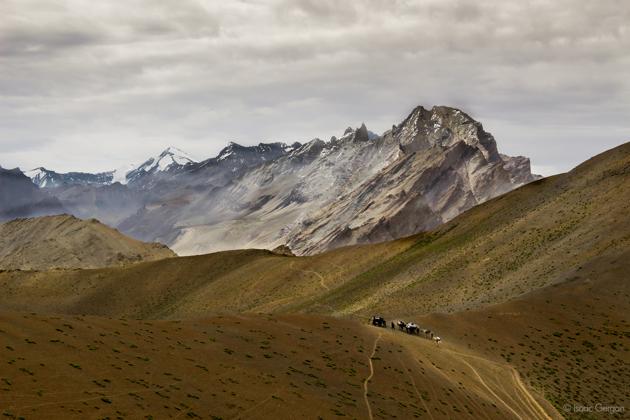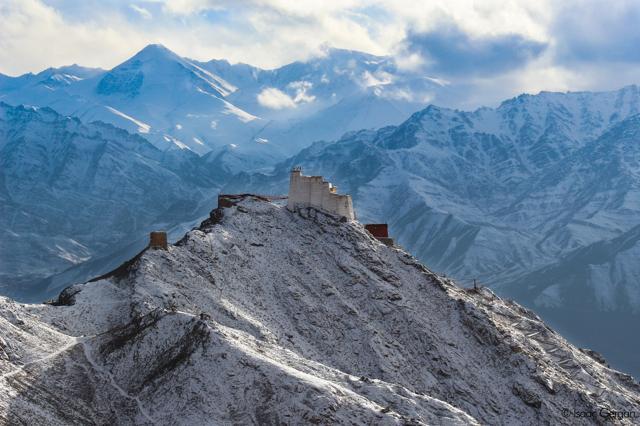Ladakh: A view from the other side
The story that Isaac Tsetan Gergan’s photo exhibition tells us is stripped of the stereotypes that this beautiful desert, Ladakh, has been reduced to.
The caption under a photo of the Zanskar valley where you can see a couple of herdsmen walking down a path with their horses, says ‘I wondered how paths were made’. Born and brought up through his early childhood in Ladakh, Isaac Tsetan Gergan left to study in Woodstock in Mussoorie and graduated in Design from the Emil Carr University of Art and Design in Vancouver, British Columbia before returning to re-trace the paths of his childhood.

In a place like Ladakh which suffers from extreme weather and has terrain that is both beautiful yet unforgiving, there is more to Gergan’s query than philosophy. After The Elusive Light, a collection of photographs that Gergan has taken over the years in Ladakh, is a view from the other side, stripped of the stereotypes that this beautiful land has been reduced to in the last few years.
The photographs on display at the IIC (India International Centre) exhibition — as is only to be expected — show a fair bit of the landscape. More important, however, to the story that Gergan is telling are the photographs of the people, kitchens, homes and even the odd flower that restores the idea of the place as the people’s own.

Curiously, most of the portraits are in black and white. “The way black and white flattens an image and brings out the face more than colour does, fascinates me. So I change them in post-processing,” Gergan says. In a way, Gergan’s method echoes the larger narrative of Ladakh that has been wrested from its local people, reducing them to an appendage to those who arrive and consume the place as fodder.
Consequently, a lot has changed in Ladakh. “The one thing I have, sadly, seen changing over the last few years is the erosion of the community. There was a time when a marriage in the community meant that every other family would contribute ₹500. And when another marriage would take place, they would return the favour with ₹510. People helped each other. With tourism and all the money coming in, that has stopped. People now only compete,” Gergan says.
Ladakh’s own story is a million miles away from the pictures of its lakes and valleys that cascade through social media pages in the summers, when everyone from Delhi to Mumbai is a traveller. It is one of the most fragile ecosystems in the world, one of the rarest cold deserts – where it snows more than it rains – and has a history that is rich, both in tradition and politics.

A picture of a Ladakhi kitchen is evidence of the difficult life that poses unique challenges, and therefore requires unique solutions. “There is huge scarcity of water. Ladakh is completely dependent on glaciers for water. So there have to be methods to tackle the situation. A majority of the toilets, for example, are built on the second floor, and are dry toilets so the waste can later used as manure. But with the influx of tourists, water tanks are coming up everywhere, and all of this will be at the expense of the local reserves, “ Gergan says.
There is an irony here, of Ladakh having become so mainstream an idea on the outside, it is prepared to self-destruct to be able to hold onto that idea.
More than half of Ladakh’s economy is run by tourism, which is roughly a six month window in the summer. During the winter, it recuperates and plans ahead. But the damage done by half-a-year of laying the carpet out for outsiders has increased exponentially over the last few years.

“The sheer amount of garbage that people bring into Ladakh is horrifying. Because you see, the place is landlocked and there is no way to get the garbage to go away. Even the water toilets are eventually only contaminating local water bodies that we depend on,” Gergan says.
Ladakh for six months in the winter disappears from everyone’s memory. It is as if it does not exist. As a result, Gergan says, local people have started looking elsewhere as well. “Very few people stay back in the winter. Everyone is now buying a house in Jammu or Delhi, and they move out when the winter starts. The ones who stay back hold a lot of festivities. Most marriages there happen in the winter,” he adds.
Ladakh is home to a growing space for research and art. Unfortunately, it is only the one-way commercial temptation of momentarily inhabiting obscure landscapes that people partake in. Gergan’s photographs, though some of them might feel like déjà vu, attempt to distance Ladakh from the view that has become common on the outside.

Quite effectively, he has chosen to caption his photos with little stories and thoughts, as one who wants to write more than just a travel article might. Does it scare him then, the way people treat his town a bit like a park?” Yes it does. But I take positives out of the fact that most of the region is still undiscovered, and inaccessible, most of Kargil for example. But I can see how things will continue to change,” he pauses and says, laughing, “You know, it is like the worst of your enemies and the best of your friends visit Ladakh.”
What: After The Elusive Light: Photographing Ladakh
When: 11 am to 7 pm, till July 11
Where: Art Gallery, Annexe Building, India International Centre (IIC), 40 Max Mueller Marg, Lodhi Estate
Nearest Metro Station: Khan Market





